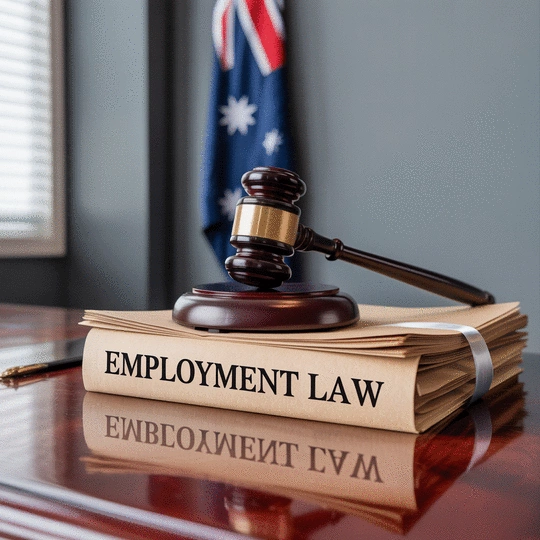Understanding Unfair Dismissal Laws

Posted on: 2025-10-27
By: Clara Thompson
Did you know that a single unfair dismissal claim can lead to significant emotional and financial stress for both employees and employers? Understanding the nuances of unfair dismissal is crucial for everyone involved in the workplace. Here’s a look at some essential lessons you can take away from this article.
What You Will Learn
- Unfair Dismissal Defined: It's not just about losing a job, but how the dismissal process is executed, focusing on harsh, unjust, or unreasonable treatment.
- Identifying Harsh Treatment: Dismissals can be deemed harsh if the penalties feel disproportionate to any alleged misconduct, such as minor mistakes resulting in termination.
- Understanding Genuine Redundancy: Employees must be informed and consulted about redundancy processes, differentiating it from an unfair dismissal.
- Preventing Claims through Documentation: Employers should maintain accurate employee records and follow the Small Business Fair Dismissal Code to mitigate risks of unfair dismissal claims.
- Creating Open Communication: Regular one-on-one meetings and constructive feedback foster a culture where employees feel heard, reducing the likelihood of grievances.
- Establishing Clear Policies: Well-communicated grievance and disciplinary procedures enhance trust and protect businesses from potential disputes.
- Regular Training and Updates: It's essential for both employers and employees to be familiar with workplace policies and ensure they are updated according to current laws.
Understanding Unfair Dismissal and Employment Termination
Key points regarding unfair dismissal, genuine redundancy, and serious misconduct that every employee and employer should understand.
Unfair Dismissal
Occurs when an employee is terminated in a harsh, unjust, or unreasonable manner. Key characteristics include:
- • Harsh Treatment
- • Unjust Reasons
- • Unreasonable Process
Genuine Redundancy
Occurs when a position is no longer needed. Employers must consult employees and follow proper procedures.
Serious Misconduct
Justifies termination without notice in cases like theft or violence. Must be substantiated with evidence.
Best Practices for Avoiding Claims
Employers should maintain proper documentation and compliance with dismissal codes to prevent unfair dismissal claims.
Understanding Unfair Dismissal in Australia: Key Definitions and Concepts
Navigating the world of unfair dismissal can be tricky, but it’s essential for every employee to understand their rights. At Employment Law Solutions, we believe that knowledge is power. So, let’s dive into the key definitions and concepts surrounding unfair dismissal in Australia.
Defining Unfair Dismissal: What Employees Need to Know
Unfair dismissal occurs when an employee is terminated from their job in a harsh, unjust, or unreasonable manner. It’s not just about losing a job; it’s about how the dismissal was carried out. Employees need to know that if they feel their termination was unfair, they may have grounds for a claim.
To better understand unfair dismissal, here are some key points to keep in mind:
- Harsh Treatment: If the dismissal feels excessively severe compared to the situation.
- Unjust Reasons: If the employee was not given a valid reason for their termination.
- Unreasonable Process: If proper procedures were not followed when terminating the employment.
Characteristics of Unfair Dismissal: Harsh, Unjust, and Unreasonable
Understanding the qualities of unfair dismissal helps employees identify if they have been treated unfairly. A dismissal can be considered harsh if it seems disproportionate to any alleged misconduct. For instance, an employee may be let go for minor mistakes without proper warnings, which can be deemed unfair.
Similarly, a dismissal is unjust if the employee wasn’t given a chance to explain their side of the story. Furthermore, if the employer fails to follow established company processes for termination, that could be classified as unreasonable. It's vital to recognize these traits as they form the basis for potential claims. The Fair Work Commission provides comprehensive information on what constitutes an unfair dismissal application, offering guidance on eligibility and processes.
Distinguishing Between Unfair Dismissal and Other Employment Terminations
Many employees wonder how unfair dismissal differs from other types of termination. It’s essential to clarify these distinctions, as they can influence the outcome of a case. For instance, genuine redundancy and serious misconduct are valid reasons for termination that don’t fall under unfair dismissal.
Here are some key differences to consider:
- Genuine Redundancy: This occurs when a position is no longer needed. Employees must be informed and consulted about the redundancy process.
- Serious Misconduct: If an employee engages in behavior such as theft or violence, this may justify termination without notice.
Understanding Genuine Redundancy and Serious Misconduct
It’s crucial for employees to understand what constitutes genuine redundancy. An employer must demonstrate that the role has become redundant and follow the correct procedures. This includes offering alternative positions if available.
On the other hand, serious misconduct requires immediate action, but it must be substantiated with evidence. If you think you have been dismissed unfairly, I recommend discussing your situation with a professional to get tailored advice. At Employment Law Solutions, we are here to guide you through this complex journey!
Pro Tip
Did you know? One of the most effective ways to prevent unfair dismissal claims is to implement a comprehensive onboarding process that includes training on workplace policies and employee rights. This proactive approach not only sets clear expectations but also fosters an environment of trust and transparency from the start.
Frequently Asked Questions About Unfair Dismissal
- What constitutes an unfair dismissal?
- An unfair dismissal occurs when an employee is terminated in a harsh, unjust, or unreasonable manner, considering factors like the severity of the treatment, the validity of the reasons, and whether proper procedures were followed.
- How does "harsh treatment" relate to unfair dismissal?
- Harsh treatment refers to a dismissal where the penalty (termination) is disproportionately severe compared to the alleged misconduct, such as being fired for minor mistakes without prior warnings.
- What is the difference between unfair dismissal and genuine redundancy?
- Unfair dismissal relates to the manner and reasons for termination, while genuine redundancy occurs when an employee's position is no longer needed by the business and proper consultation processes are followed.
- Can serious misconduct lead to immediate termination?
- Yes, serious misconduct (like theft or violence) can justify immediate termination without notice, provided it is properly substantiated with evidence.
- What role does documentation play in avoiding unfair dismissal claims?
- Maintaining clear and accurate employee records, including performance reviews and disciplinary actions, is crucial for employers to justify dismissal decisions and defend against potential claims.
- What is the Small Business Fair Dismissal Code?
- The Small Business Fair Dismissal Code provides a framework for small businesses to ensure fair and lawful dismissal processes, helping them reduce the risk of unfair dismissal claims.
- How can open communication help prevent grievances?
- Regular one-on-one meetings and constructive feedback create a culture where employees feel heard and understood, reducing the likelihood of grievances and fostering a more positive workplace environment.
- Why are clear grievance and disciplinary procedures important?
- Clear grievance and disciplinary procedures establish expectations for both employers and employees, allow concerns to be voiced without fear of retaliation, and promote transparency and fairness in the workplace.
Best Practices for Employers to Avoid Unfair Dismissal Claims
Avoiding unfair dismissal claims is crucial for any employer looking to maintain a healthy workplace environment. As someone who has navigated the intricate pathways of Australian employment law through my work at Employment Law Solutions, I understand the importance of proactive measures. When employers take the time to implement effective strategies, they not only protect their organization but also foster a culture of respect and fairness.
One of the most significant aspects of preventing unfair dismissal claims is maintaining proper documentation and compliance. Being organized with your records can save you from potential legal headaches down the road. Here are a few essential guidelines to follow:
- Keep clear and accurate employee records.
- Document performance reviews and disciplinary actions.
- Ensure compliance with the Small Business Fair Dismissal Code.
Documentation and Compliance: Essential Guidelines for Employers
Documentation plays a pivotal role in justifying dismissal decisions. The more thorough you are, the better equipped you'll be to defend against claims. Additionally, understanding the Small Business Fair Dismissal Code is crucial for small businesses, as it provides a framework for fair and lawful dismissal. For more detailed information on workplace rights and responsibilities, the U.S. Department of Labor offers a wealth of resources that can help both employers and employees navigate complex legal landscapes.
Here are some key points to consider:
- Familiarize yourself with the criteria outlined in the Code.
- Ensure that employees are aware of workplace policies.
- Conduct regular training sessions on fair dismissal practices.
By following these steps, you can create a solid foundation for compliance and reduce the likelihood of claims. It’s all about doing your homework and being transparent in your practices!
Implementing the Small Business Fair Dismissal Code
Implementing the Small Business Fair Dismissal Code effectively can significantly reduce the risk of unfair dismissal claims. This Code not only outlines the fair dismissal process but also helps foster employee trust. Here are some practical ways to ensure you're aligned:
- Communicate the Code to all employees during onboarding.
- Regularly review and update your dismissal practices in line with the Code.
- Encourage feedback from employees regarding their understanding of the Code.
Remember, clarity and transparency are your allies when it comes to fostering a supportive work environment.
Creating a Fair Workplace: Strategies to Reduce Risk
Creating a fair workplace starts with open communication. When employees feel heard and understood, they're less likely to feel marginalized or mistreated. Here’s how to ensure your communication is effective:
- Hold regular one-on-one meetings to discuss employee concerns.
- Provide constructive feedback, focusing on growth and development.
- Encourage a culture where employees feel comfortable voicing their thoughts.
Performance management is also key. Having a clear framework for assessing employee performance can prevent misunderstandings and grievances, setting the stage for a harmonious workplace.
Employee Communication and Performance Management Tips
Encouraging open dialogue around performance management can significantly reduce the risk of unfair dismissal claims. Here are some strategies you can adopt:
- Establish clear performance metrics and expectations.
- Use regular performance appraisals to track progress.
- Address issues promptly and fairly, aiming for resolutions rather than punitive measures.
These strategies create a positive feedback loop, where employees feel valued and engaged in their roles.
Developing Effective Workplace Policies
Finally, having effective workplace policies can set expectations for both employers and employees. These policies should be well-communicated and accessible to everyone in the organization. Here’s what to focus on:
- Create clear and concise grievance procedures.
- Outline disciplinary procedures that are fair and transparent.
- Ensure that all policies are compliant with current employment laws.
By establishing these frameworks, you're not only protecting your business but also promoting a respectful and supportive workplace.
Establishing Grievance Procedures and Disciplinary Procedures
Establishing clear grievance and disciplinary procedures is essential to preventing disputes. These procedures should allow employees to voice their concerns without fear of retaliation. Here’s how to create effective procedures:
- Make the process straightforward and easy to navigate.
- Ensure that all employees are trained on the procedures.
- Regularly review and update policies to reflect changes in the law or workplace culture.
Having a structured approach to handling grievances and disciplinary actions can enhance trust within your team and strengthen your company’s reputation.
In conclusion, employers can take proactive steps to prevent unfair dismissal claims by focusing on documentation, communication, and workplace policies. By fostering a culture of transparency and fairness, you’ll not only protect your business but also create an environment where employees feel valued and respected. At Employment Law Solutions, I encourage all employers to explore these best practices to promote a positive workplace for all!
Recap of Key Points
Here is a quick recap of the important points discussed in the article:
- Understanding Unfair Dismissal: Unfair dismissal is characterized by harsh treatment, unjust reasons, and unreasonable processes during termination.
- Distinctions in Termination: Know the differences between unfair dismissal, genuine redundancy, and serious misconduct to better understand your rights.
- Documentation and Compliance: Employers should maintain clear employee records and document performance reviews to defend against unfair dismissal claims.
- Implement the Small Business Fair Dismissal Code: Ensure all employees are aware and compliant with the Code to foster a fair dismissal process.
- Effective Communication: Open dialogue and regular performance management can help prevent misunderstandings and grievances in the workplace.
- Developing Workplace Policies: Establish clear grievance and disciplinary procedures that comply with employment laws to promote a respectful working environment.
 Understanding your rights in the workplace is not just beneficial; it's essential. With 1 in 5 Austr
Understanding your rights in the workplace is not just beneficial; it's essential. With 1 in 5 Austr
 Understanding unfair dismissal appeals can feel like navigating a maze. Did you know that nearly 20%
Understanding unfair dismissal appeals can feel like navigating a maze. Did you know that nearly 20%
 Contract compliance is more than just a legal obligation—it's a cornerstone of effective business
Contract compliance is more than just a legal obligation—it's a cornerstone of effective business
